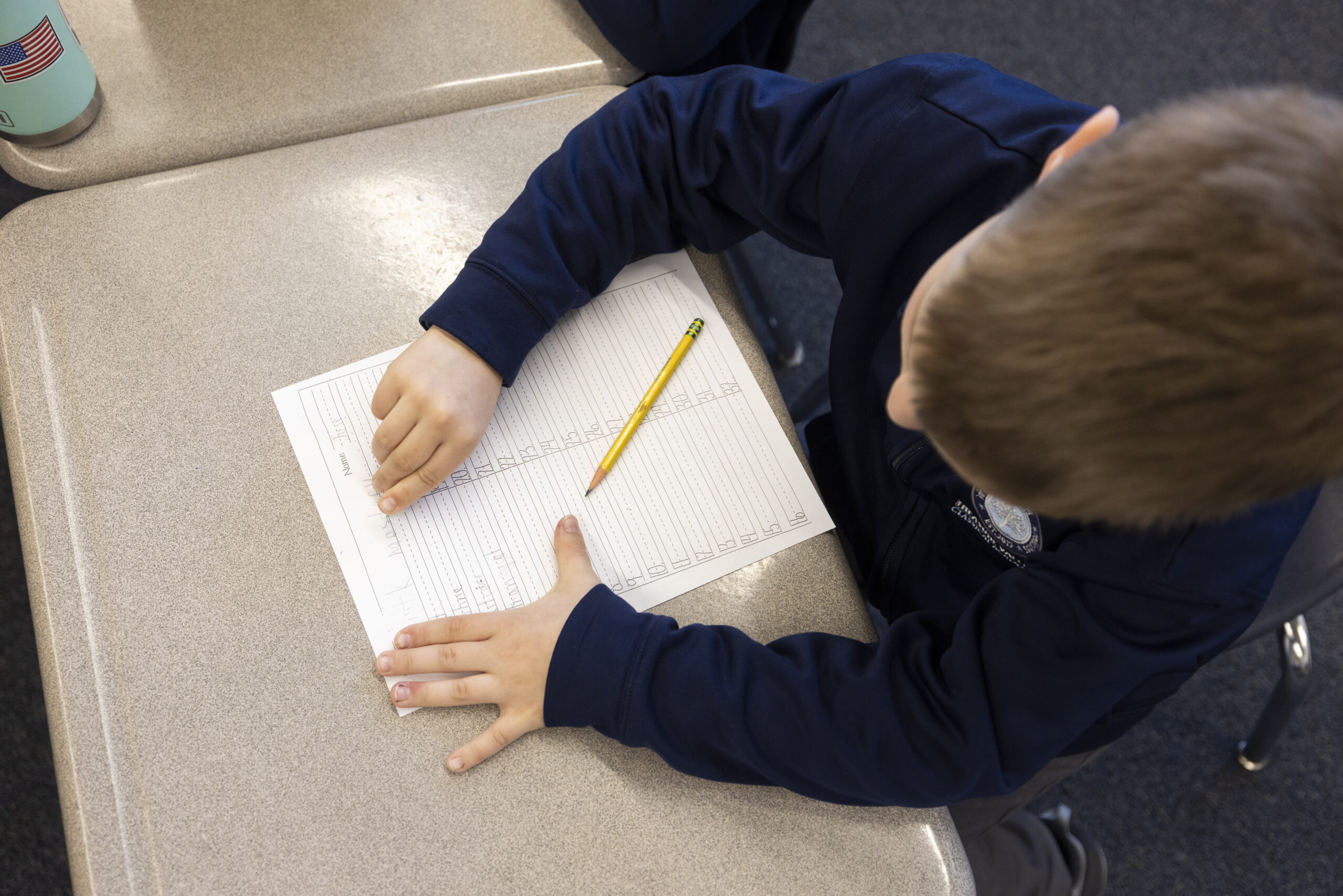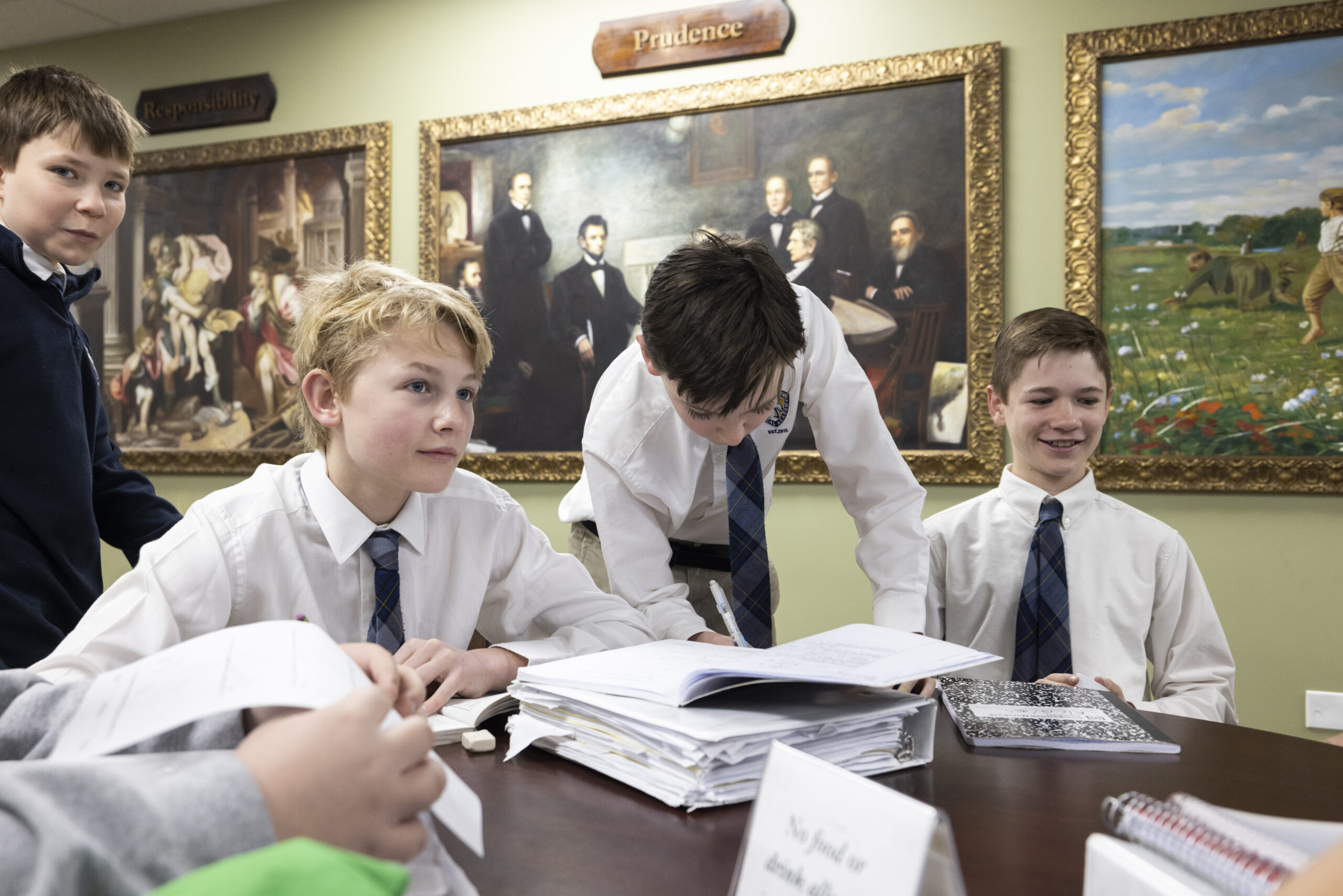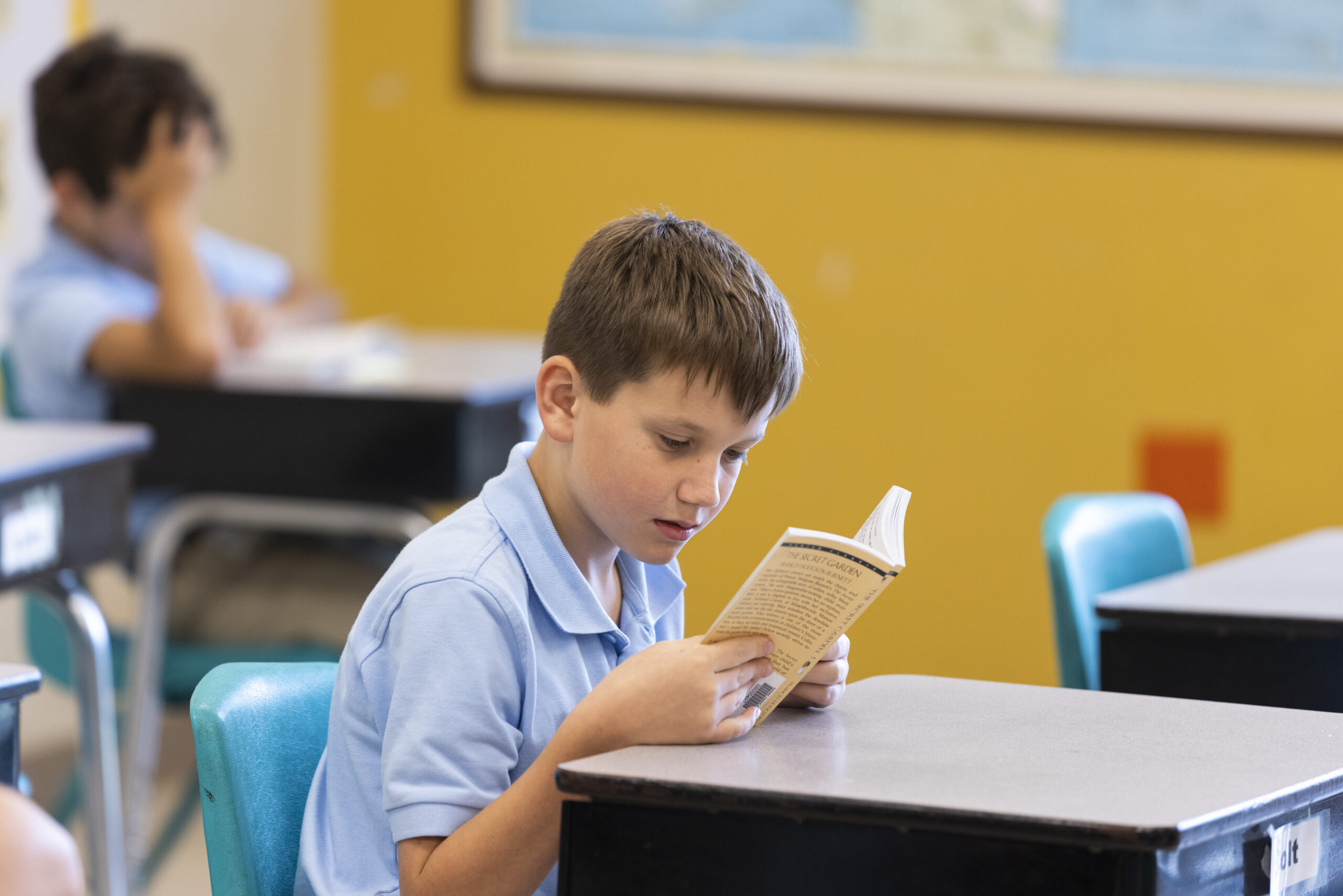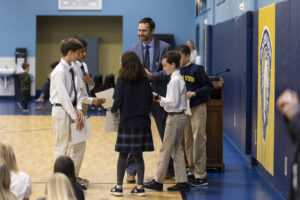an introduction to Hillsdale College’s approach to teaching English language arts in the K-12 years

English Language Arts
Since antiquity, a liberal education (i.e., an education for free human beings) has prioritized the study of language. This study of language focused the students’ attention on three arts: grammar, the rules that govern a particular language; logic, the means of separating truth from error; and rhetoric, the manners of eloquent persuasion through speaking and writing. In the Middle Ages, these three arts were called the trivium or “the place where three roads meet” (tri + via). Together with the four mathematical arts or quadrivium (arithmetic, geometry, music, and astronomy), the trivium made up the seven liberal arts.
While grammar, logic, and rhetoric continue to play important roles in a quality education, the term “language arts” is often used to refer to a set of language skills that serve students throughout the curriculum. In the essay “Of Studies” (1625), Francis Bacon identifies these language skills and points us to their practical purpose when he says,
“Reading maketh a full man; conference a ready man; and writing an exact man.”
In other words, reading gives us knowledge of the world, conference (listening and speaking) prepares us to interact with others, and writing forces us to arrange our thoughts with precision.
In classical schools today, the curriculum must include a variety of important subjects: history, mathematics, visual arts, science, music, physical education, and others. But as it was in antiquity, language instruction—in the form of reading, listening, speaking, writing, and grammar—must play a central role in the earliest years of schooling.
Reading
To read is to make meaning from text, and it is one of the foundational reasons why children come to school. In the lower elementary grades, we often explain that students are “learning to read.” This means that they are using their knowledge of the predictable relationships between letters and sounds (or phonics) to decode words. Learning to read, however, encompasses more than the ability to sound out the words. Children also need direct, explicit instruction in fluency (the ability to read with automaticity, correct intonation, and proper phrasing), vocabulary (rooted in content-rich lessons, morphology, Greek and Latin roots, and meaningful practices with words), and comprehension (the ability to make connections, identify main ideas and supporting details, make inferences, and develop analyses of what is read). These latter skills are taught in part in the younger grades, but children are still learning to read in grades 3-8 as they encounter more complex texts that require higher cognitive demands.
Assuming that the child has experienced a language-rich environment that includes exposure to both the alphabet and the sounds of English in the early years of development, the average kindergarten student should be ready for a course of study that makes explicit the relationship between letters and their possible sounds. If the child has not experienced a language-rich environment in his early life or if the child has some difficulties learning, then the school may have to modify reading instruction accordingly. These necessary modifications should not, however, involve an abandonment of the explicit phonics curriculum. In connection with a rigorous spelling program, lower elementary students should increase their speed and accuracy of connecting letters and sounds as they develop their fluency as readers.
Children are learning to read for many years, and a thoughtful approach to teaching reading includes thinking about how a student can engage with the works of great authors and how he will practice what a teacher models in thinking about difficult passages.
Most elementary-level students make an important shift in their reading ability by the third or fourth grade. In their first years of schooling, the students were “learning to read,” but by the third and fourth grade, students have become fluent enough decoders of text that they can now use these decoding skills as a tool for learning: they are “reading to learn.” This ability to comprehend text was limited in earlier grades because so much of the students’ mental capacity was focused on decoding. But in the middle and upper elementary grades, the students are much more fluent readers, and their minds are free to focus on the meaning of the text rather than the relationship between sounds and symbols. In the upper-elementary years, students should continue to improve their fluency as readers and should learn more about the nature of words (e.g., compounds, synonyms, antonyms, and homonyms) and their meaningful parts (i.e., roots, prefixes, suffixes) through a rich vocabulary and spelling program.
If a child cannot decode text, he or she cannot make meaning from the text, but the same is true for a student who can decode but who lacks background knowledge or the ability to use reading strategies when they are stuck in a difficult text. The phrases “learning to read” and “reading to learn” do not then imply that reading instruction halts after the second grade. In some respects, it is critical that reading instruction becomes even more targeted as students are exposed to more challenging books and ideas. Children are learning to read for many years, and a thoughtful approach to teaching reading includes thinking about how a student can engage with the works of great authors and how he will practice what a teacher models in her thinking about difficult passages.
Conversation: Listening & Speaking
Unlike reading and writing, listening and speaking do not require the use of abstract written symbols (i.e., letters), and therefore these two language skills can be acquired naturally without direct, explicit instruction. Despite this difference most educators agree that even the more “natural” language skills such as listening and speaking can and should be cultivated through quality instruction and practice.
In the elementary grades, teachers can help students become better listeners and speakers through a variety of activities. First, teachers should preserve time in the school day to read aloud to their students. The type of texts can vary (e.g., fiction, history, and biography), but reading aloud allows teachers to expose students to works of literature that the students may not yet be able to read on their own. Furthermore, reading aloud fosters habits of attentive listening in a way that students find delightful rather than restrictive. Finally, a talented reader can bring texts alive for students, giving emphasis and color in the reading that allows students to gain a deeper appreciation and understanding of the work. Considering this, reading aloud should be regarded as a positive good that teachers regularly perform, rather than simply a crutch for students who are too young to read for themselves. During these read-alouds, the students should learn how to sit still and listen quietly to the teacher. In addition, the teacher should stop periodically to ask questions of the students and engage them in the kinds of activities that a mature reader does automatically.
Second, teachers should lead short, focused class discussions in a variety of subjects, and they should model the kinds of questions and answers—not to mention the attitude and manners—that are essential to a healthy discussion. While some of the questions that a teacher might ask at this level will be closed-ended (i.e., what, who, where, and when?), the teacher should also introduce more open- ended questions (i.e., how and why?) that will lead to more fruitful discussions. These kinds of inquiries will lay a foundation for more in-depth seminars in the middle- and high-school grades.
Third, teachers should require students to memorize and recite great works of poetry and famous speeches. The teacher should take time to describe and model what a quality recitation looks and sounds like. Students can perform these recitations as a class and in small groups, but they should also have the opportunity to recite something by themselves to the teacher, in front of the class, or at a special event. The memorization of speeches and poetry holds a time-honored place in classical education and is a good in its own right. A robust memory, stored with fine and beautiful poems, speeches, and passages, constitutes a real form of knowledge that will have an enduring influence on the student’s character and will equip the student with important intellectual resources.
Fourth, students should have opportunities to speak their own words—both prepared and extemporaneous. In the lower grades, this might involve something like a brief show-and-tell activity where a student must talk about an object for 1-2 minutes and answer 1-2 questions from the teacher and his peers. In the upper-elementary grades, the student might need to present a brief oral summary to the class on a topic from history, science, or art. All of these activities are preparing students to be good listeners and speakers, and they are laying the foundation for much more difficult listening and speaking requirements in the upper-school grades.
Writing
As it was with the other language arts, writing instruction in the elementary grades is all about preparing students for what is to come. Writing instruction in kindergarten will begin with forming individual letters. Although there are exceptions, most handwriting (or penmanship) programs begin with manuscript (also known as “printing”) rather than cursive. Cursive should be part of a quality writing curriculum, but most often this instruction will begin only after the students can successfully form both the lowercase and uppercase letters in manuscript. In most cases this means that cursive instruction will begin in the second half of the second grade year or later. Some handwriting programs introduce forms of the letter—uppercase and lowercase—concurrently. If only one form of the letter is introduced at this level, it will most likely be the lowercase because lowercase occurs more frequently in texts. Many students struggle to form letters correctly at this level because their fine-motor skills are still developing, but most students can develop good handwriting with plenty of regular practice and consistent feedback from the teacher.
Throughout the lower elementary grades, students should progress from letters to words to sentences to paragraphs so that by the end of the third grade, students are able to compose a quality paragraph. Students should recognize that a paragraph is a mini-argument, and they should be able to write single paragraphs on a variety of topics, including a topic sentence that clearly states a central idea and secondary sentences that support the topic sentence through evidence or examples. In the upper elementary grades, students should learn how to connect a series of paragraphs together. By the end of the sixth grade, students should be able to write a concise, well-crafted essay of four or more paragraphs that includes an introduction, body, and conclusion.
As students mature in their writing in the middle and high school grades, it is essential that teachers maintain a firm relationship between writing and thinking. Writing must begin with a clear idea and end with the clear and persuasive communication of that idea to others. This means that various forms, models, and templates (like the “5-paragraph essay”) may help to guide students, but using these templates is not writing in its fullest sense, and overdependence on them may hinder students in their development as writers. Rather, teachers should introduce students to tools for writing and demand that they use them, guide them and nurture them as writers, and encourage them to think critically and independently. While students will undoubtedly be required to write certain forms of essays (e.g., a compare/contrast essay, a definition essay, a process essay, a personal narrative, a lab report, etc.), each must learn that the requirements of a particular assignment are intended as a vehicle for the clear communication of his or her own thoughts. It may be more difficult to teach writing this way, but students will be immeasurably better for it.
Learning to write is hard work and is perhaps harder still to teach. In order to strike a balance between a clear writing process and the necessary intellectual participation on the part of the individual writer, teachers must work to create a habit of mind in their students. The fundamentals of writing ought to be grounded in logic, focus, purpose, and organization. In most cases, writing will begin with compiling ideas and planning their layout, proceed with a great deal of practice, and finish with honing and revision. Teachers must encourage students to be deliberate in the goals of their writing—and this means in all of their writing, in all of their classes. Each discipline asks something different from the students in form and content; however, one thing should remain the same in every class: students should have a clear sense of purpose to writing, namely to communicate their thoughts in a cohesive, organized, and clear manner.
As our students develop through the grammar and logic of using various forms and tools to communicate clearly, they will also develop in their rhetorical capacity. Ultimately students should learn to think and write symphonically, with each paragraph working in harmony with other paragraphs to offer the reader the student’s thoughts. Good writing is like a chess match, where every move is connected to every other move. Teachers are working to develop in their students both a touch of the poet and a touch of the engineer. Teachers must recognize that they are developing the writer rather than the composition. In pursuit of this end, they can build a strong foundation in the fundamentals, model clear thinking, critique poor thinking, and coach students in the elements of style and rhetorical effectiveness.
English Grammar
While all three classical language arts (the trivium) have been indirectly represented in the descriptions above, grammar deserves special attention in the elementary grades. To most readers, it will come as no surprise that explicit English grammar instruction has been all but ignored in modern public schooling. For a detailed explanation of how and why this happened, see David Mulroy’s insightful book The War Against Grammar. When modern public schools do offer explicit English grammar instruction, teachers most often address it quickly and minimally so that the class can move on to something more practical like writing. But while knowledge of grammar often does help students become better at reading, writing, speaking, and listening, grammar is worth knowing for its own sake—just like biology, mathematics, and history—and it deserves to be taught slowly and carefully over a number of years.
In the lower elementary grades, the emphasis should be on teaching students how to read. This task is difficult and time-consuming, and if students do not focus on learning to read during these early years, they will struggle to succeed throughout the rest of their schooling. However, students can still begin to learn some basic terms and concept in the first few years of school. Lower elementary teachers should begin to introduce grammar terms so that by the end of the second grade, students have learned basic definitions for all eight parts of speech. If students have this knowledge by the end of the second grade, then they will be prepared for a more comprehensive program in the coming years.
If students have made adequate progress in learning to read and have acquired some basic grammar terminology, the third grade is the best time to begin an explicit, systematic English grammar instruction program. In four years (grades 3-6), students should be able to acquire a basic understanding of the nature and function of English grammar that begins with the basic elements of a sentence and concludes with compound-complex sentences. Because of elementary students’ natural capacity to acquire language both implicitly and explicitly, schools should not wait until the middle- school years to begin explicit grammar instruction. Schools should make every effort to capitalize on this post-reading and pre-puberty window to teach students English grammar. If students receive quality grammar instruction in the upper elementary grades, then all middle and upperschool teachers will be able to hold students accountable for proper grammar, and they will be able to use language to teach students other content.
More Posts about Reading, Writing, and Speaking
-
Literacy Essentials and Plato’s Gorgias: Part 2
Last week we examined Literacy Essentials from the macro level and saw how speech grounds every level of human reality. We considered the question of those who threaten our use of language and what purposes they might have. In Plato’s dialogue Gorgias, Socrates engages in discussion with a sophist named Gorgias. In ancient Athens, the…
-
Literacy Essentials and Plato’s Gorgias: Part 1
A few weeks ago, I started a job up at Hillsdale College as a Classical Pedagogy Trainer. As a CPT, I will support classical pedagogy in classrooms at Hillsdale Member K-12 Schools. My background is largely in the Upper School, teaching subjects from 6th to 12th Grade — 6th Grade History, 9th Grade Literature and…
-
Behind the Scenes at the Filming of our New Literacy Training Course
The K-12 Education Office provides training and advice for teachers across our network, and one of the most important aspects of elementary education is learning to read and write. Check out this post to see the different ways we encourage teachers in this area of instruction!… Continue reading Behind the Scenes at the Filming of…
-
When I’m Proud of My Students
French students from Seven Oaks Classical School had the opportunity to participate in a statewide French language and culture competition called “Le Congres.” At this annual event, students test their skill in knowledge-based contests such as vocabulary, history, and geography questionnaires as well as their oral production of the language in reading previously unseen texts……
-
The Importance of Rest in Classical Education
“Pourquoi est-ce que les vacances scolaires sont importantes?” Posing the question “Why are school breaks important?” to a room of high schoolers four days before the end of first semester garnered the exact passionate responses I anticipated from these tired youths. After some time for reflection, I recorded the class’ reactions on the board: “Nous…
-
“I don’t remember any of it.”
The goal of students’ education is not perfection, nor is it merely practical skills and good grades. The goal is not even getting an amazing job or getting into the right college. The goal is for students to appreciate what is true, good, and beautiful in the subjects they learn, so they can see what…
-
How “Literacy Essentials” Is a Game-Changer for Reading
“Literacy Essentials” provides students with the tools to be able to spell and read hundreds of words. We want to set our students up for a successful, lifelong pursuit of reading for both pleasure and enlightenment, and this is the best way to place them on that path.… Continue reading How “Literacy Essentials” Is a…
-
Learning Cursive in 2nd Grade
While I was visiting classrooms a couple of weeks ago, I got to see our second graders learning cursive handwriting with Mrs. Horton and Ms. Sowell. They were working on capital letters and sentences from their literature and history studies. Handwriting practice is an essential part of our students’ elementary education in K-2, and after……











